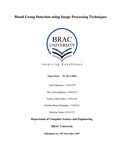| dc.contributor.advisor | Uddin, Dr. Jia | |
| dc.contributor.author | Rahman, Sakib | |
| dc.contributor.author | Rahman, Md. Atifur | |
| dc.contributor.author | Khan, Fariha Ashraf | |
| dc.contributor.author | Shahjahan, Shabiba Binte | |
| dc.contributor.author | Nahar, Khairun | |
| dc.date.accessioned | 2018-02-18T09:47:46Z | |
| dc.date.available | 2018-02-18T09:47:46Z | |
| dc.date.copyright | 2017 | |
| dc.date.issued | 12/24/2017 | |
| dc.identifier.other | ID 13101279 | |
| dc.identifier.other | ID 13101273 | |
| dc.identifier.other | ID 13101262 | |
| dc.identifier.other | ID 13301021 | |
| dc.identifier.other | ID 13101175 | |
| dc.identifier.uri | http://hdl.handle.net/10361/9503 | |
| dc.description | Cataloged from PDF version of thesis report. | |
| dc.description | Includes bibliographical references (pages 29-31). | |
| dc.description | This thesis report is submitted in partial fulfilment of the requirements for the degree of Bachelor of Science in Computer Science and Engineering, 2017. | en_US |
| dc.description.abstract | Blood grouping is the first and foremost essentiality for many of the major medical procedures. Traditional ways of detecting blood group have remained analogue in this era of digitization and are therefore susceptible to human fallibility. So it would be very efficient and arguably a lifesaving approach if the process of detecting blood can be completed successfully in a cost-effective way with the technologies at hand and without the plausibility of man-made error. This proposition is expected to evaluate the Rh factor as well as the group of a sample blood with its computed image. The whole process excludes a major probability of human error while detecting the agglutination from the traditional method and it would get the task done within a fairly insignificant amount of time. The procedure will start by taking a photo of the sample blood slide followed by the application of a number of algorithms such as grayscale, binary and canny edge detection on it. After that, the detected edges will be counted and thus we will decide the agglutination. The method is established upon real-time dataset including 100 blood samples of people of different ages. The experimental result is almost accurate compared to the real time results from the sample dataset. It can, therefore, conclude the procedure with certain numeric values which were determined after real-time data analysis of images from a mobile camera, to make it simpler and more precise. | en_US |
| dc.description.statementofresponsibility | Sakib Rahman | |
| dc.description.statementofresponsibility | Md. Atifur Rahman | |
| dc.description.statementofresponsibility | Fariha Ashraf Khan | |
| dc.description.statementofresponsibility | Shabiba Binte Shahjahan | |
| dc.description.statementofresponsibility | Khairun Nahar | |
| dc.format.extent | 31 pages | |
| dc.language.iso | en | en_US |
| dc.publisher | BRAC University | en_US |
| dc.rights | BRAC University thesis reports are protected by copyright. They may be viewed from this source for any purpose, but reproduction or distribution in any format is prohibited without written permission. | |
| dc.subject | Blood group | en_US |
| dc.subject | Image processing technique | en_US |
| dc.title | Blood group detection using image processing techniques | en_US |
| dc.type | Thesis | en_US |
| dc.contributor.department | Department of Computer Science and Engineering, BRAC University | |
| dc.description.degree | B. Computer Science and Engineering | |

